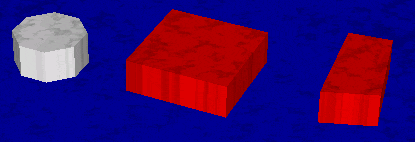| PathEngine home | previous: | next: |
iShape objects store a 2d polygon and are used to represent the shape of an agent or a moveable obstruction for the purposes of PathEngine collision.
The following code (in main.cpp) is used to create three iShape objects:
unique_ptr<iShape> agent_shape;
unique_ptr<iShape> obstruction_shape1;
unique_ptr<iShape> obstruction_shape2;
{
int32_t array[]=
{
8,20,
20,8,
20,-8,
8,-20,
-8,-20,
-20,-8,
-20,8,
-8,20,
};
agent_shape = pathengine->newShape(array, sizeof(array) / sizeof(*array));
}
{
int32_t array[]=
{
30,30,
30,-30,
-30,-30,
-30,30,
};
obstruction_shape1 = pathengine->newShape(array, sizeof(array) / sizeof(*array));
}
{
int32_t array[]=
{
10,35,
20,-20,
-10,-30,
-15,32,
};
obstruction_shape2 = pathengine->newShape(array, sizeof(array) / sizeof(*array));
}
|
This is what agents created with these shapes might look like rendered in the testbed:

The agent shape is a regular octagon.
The obstruction 1 shape is an axis aligned square.
The obstruction 2 shape is an irregular quadrilateral.
Note: Agents that can rotate will need to be approximated by regular polygon. Irregular shapes should only be used for agent that do not rotate.
| Documentation for PathEngine release 6.04 - Copyright © 2002-2024 PathEngine | next: |